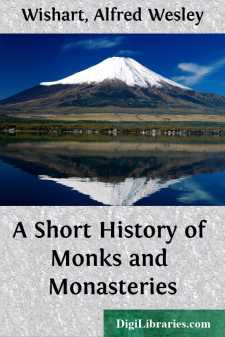Categories
- Antiques & Collectibles 13
- Architecture 36
- Art 48
- Bibles 22
- Biography & Autobiography 813
- Body, Mind & Spirit 142
- Business & Economics 28
- Children's Books 14
- Children's Fiction 11
- Computers 4
- Cooking 94
- Crafts & Hobbies 4
- Drama 346
- Education 46
- Family & Relationships 57
- Fiction 11829
- Games 19
- Gardening 17
- Health & Fitness 34
- History 1377
- House & Home 1
- Humor 147
- Juvenile Fiction 1873
- Juvenile Nonfiction 202
- Language Arts & Disciplines 88
- Law 16
- Literary Collections 686
- Literary Criticism 179
- Mathematics 13
- Medical 41
- Music 40
- Nature 179
- Non-Classifiable 1768
- Performing Arts 7
- Periodicals 1453
- Philosophy 64
- Photography 2
- Poetry 896
- Political Science 203
- Psychology 42
- Reference 154
- Religion 513
- Science 126
- Self-Help 84
- Social Science 81
- Sports & Recreation 34
- Study Aids 3
- Technology & Engineering 59
- Transportation 23
- Travel 463
- True Crime 29
A Short History of Monks and Monasteries
Description:
Excerpt
I
The monk is a type of religious character by no means peculiar to Christianity. Every great religion in ancient and modern times has expressed itself in some form of monastic life.
The origin of the institution is lost in antiquity. Its genesis and gradual progress through the centuries are like the movement of a mighty river springing from obscure sources, but gathering volume by the contributions of a multitude of springs, brooks, and lesser rivers, entering the main stream at various stages in its progress. While the mysterious source of the monastic stream may not be found, it is easy to discover many different influences and causes that tended to keep the mighty current flowing majestically on. It is not so easy to determine which of these forces was the greatest.
"Monasticism," says Schaff, "proceeds from religious seriousness, enthusiasm and ambition; from a sense of the vanity of the world, and an inclination of noble souls toward solitude, contemplation, and freedom from the bonds of the flesh and the temptations of the world." A strong ascetic tendency in human nature, particularly active in the Orient, undoubtedly explains in a general way the origin and growth of the institution. Various forms of philosophy and religious belief fostered this monastic inclination from time to time by imparting fresh impetus to the desire for soul-purity or by deepening the sense of disgust with the world.
India is thought by some to have been the birthplace of the institution. In the sacred writings of the venerable Hindûs, portions of which have been dated as far back as 2400 B.C., there are numerous legends about holy monks and many ascetic rules. Although based on opposite philosophical principles, the earlier Brahminism and the later system, Buddhism, each tended toward ascetic practices, and they each boast to-day of long lines of monks and nuns.
The Hindoo (Brahmin) ascetic, or naked philosopher, as the Greeks called him, exhausted his imagination in devising schemes of self-torture. He buried himself with his nose just above the ground, or wore an iron collar, or suspended weights from his body. He clenched his fists until the nails grew into his palms, or kept his head turned in one direction until he was unable to turn it back. He was a miracle-worker, an oracle of wisdom, and an honored saint. He was bold, spiritually proud, capable of almost superhuman endurance. We will meet him again in the person of his Christian descendant on the banks of the Nile.
The Buddhist ascetic was, perhaps, less severe with himself, but the general spirit and form of the institution was and is the same as among the Brahmins. In each religion we observe the same selfish individualism,--a desire to save one's own soul by slavish obedience to ascetic rules,--the extinction of natural desires by self-punishment. "A Brahmin who wishes to become an ascetic," says Clarke, "must abandon his home and family and go live in the forest. His food must be roots and fruit, his clothing a bark garment or a skin, he must bathe morning and evening, and suffer his hair to grow."
The fact to be remembered, however, is that in India, centuries before the Christian Era, there existed both phases of Christian monasticism, the hermit[] and the crowded convent....


